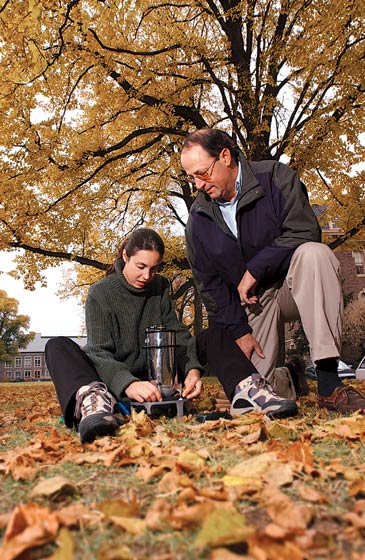One of the many research interests of Lawrence Malinconico, associate professor of geology and environmental geosciences, is volcanoes. He was interviewed about his groundbreaking work for a BBC documentary, “Volcano Hell” which premiered in the United Kingdom in early 2002 and on PBS’ NOVA in November 2002 as “Volcano’s Deadly Warning.”
Predicting when volcanoes will erupt is difficult. Early in his career, Malinconico was one of the first scientists to monitor sulfur dioxide gas emissions from Mt. Etna, Sicily, Italy, through a remote gas monitoring approach he helped pioneer. The goal was to predict an eruption based on changes in the mass of sulfur dioxide released from the volcano.
“Prior to 1973, the only way to monitor gases was to climb into the crater or around the flanks of a volcano,” Malinconico says. “I was part of a group that developed methodologies to remotely monitor gases using a device called a correlation spectrometer. It uses the path of sunlight shining through the gas plume coming out of the volcano.”
In 1977, Malinconico and his team achieved a significant breakthrough by observing variations in gas emissions before three different eruptions at Mt. Etna. “This confirmed that it was feasible to use the instrument as a short-term indicator or pre-monitoring device for volcanic eruptions,” he says.
Malinconico stresses gas monitoring only works for volcanoes with certain properties. Other indicators, such as seismic activity and deformation of volcanoes, are also important to predict eruptions. “No one technique is perfect,” he says. “You should use all techniques in conjunction with each other.”
Malinconico has taken students to Hawaii seven times for interim courses studying all aspects of the geology of the Hawaiian Islands, including Kilauea and Mauna Loa volcanoes, tectonics, volcanism, petrology, geomorphology, coral reef and beach development, and glacial deposits. “It’s a rigorous course; we’re out in the field eight to ten hours a day,” he says. “But the students enjoy it. It always fills up quickly and has a waiting list.”
What attracted him to Lafayette? “I was teaching at a big state university with less emphasis on undergraduate education,” Malinconico says. “I was teaching an introductory course with 1,000 students spread over three sections. Here, my largest lecture is 55 students in an introductory course, and I work with them in laboratory groups of 20 students or less. My upper-level courses have only five to ten students. You can do a lot with students at that level. There is a lot more personal interaction with students here.”
He is currently working with students to study the sub-surface structure of the Newark Basin, including the igneous rocks that intrude into the sediments. The Newark Basin was created when the ancient super-continent, Pangea, split apart beginning about 200 million years ago. The students use gravimeters and a magnetometer to take gravitational and magnetic measurements. “We can go beyond surface observations using geophysical data to model subsurface structures without drilling, because these intrusive diabase rocks affect the gravitational and magnetic fields of the Earth,” he says.
“Working under Dr. Malinconico is very rewarding,” says Sarah Gately ’03, who collected gravity and magnetic data in the Newark Basin with Malinconico and presented her research at two meetings of the Geological Society of America. “He cares a great deal about students and their education.”
“Larry is a great teacher in the field,” adds Carrie Ryder ’00, a geology graduate who is in the master’s program in igneous geochemistry at the University of California at Santa Cruz. “He gives students real-world problems to solve and teaches us how to use the tools to do that. He really cares that his students are learning and he never turned people away who came to see him for help.”
“Professor Malinconico introduced me to the field of geophysics,” says Meghan Keohane Rachmady ’98, senior scientist, Ensco, Springfield, Va., who earned a master’s degree in geosciences at Penn State and works in seismology and geophysical testing. “From my first semester, Professor Malinconico challenged me, both in the classroom and in the field. I learned not only basic principles and field methods, but was fortunate enough to accompany him on a consulting project in Indiana, which put those skills to the test in a real life situation. The background I gained in geophysics prepared me well for my graduate studies.”
Malinconico has studied numerous volcanoes in Guatemala, El Salvador, and Nicaragua. In addition to volcanology, Malinconico’s research interests and teaching interests include applied geophysical, tectonic, and structural studies. He has conducted research in Pakistan, Italy, Central America, Hawaii, and the Cascades.
A private pilot, he is an adviser to the local Boy Scout Aviation Explorer Post and is active in youth sports, coaching softball and baseball, and refereeing hockey and lacrosse games.
Highlights
Publications: “Fluctuations in SO2 emission during recent eruptions of Etna,” Nature, vol. 278, no. 5699, p. 43-45, 1979; coeditor, Tectonics of the Western Himalaya, GSA Special Paper #232, 1989; Malinconico, Sarah Gately ’03, Arrand Copenhaver ’02, and Andrew Fields ’02, “Gravity and Magnetic Constraints on the Structure of the Newark Basin,” GSA Abstracts with Programs, vol. 34, no. 1, 2002.
Honors: Marquis Distinguished Teaching Award, 2002; William Spurgeon Award, Boy Scouts of America, 2001.
Achievements: Associate provost, 1993-98; head, geology, 1989-97, acting head, 2002-03; co-led interim course to Hawaii seven times; chair, geophysics division, Geological Society of America, 1993-94.
Contact: (610) 330-5195; malincol@lafayette.edu

Larry Malinconico and Sarah Gately ’03, geology major, use a gravitimeter to take measurements on the Quad in front of Pardee Hall.
